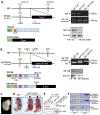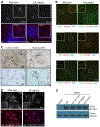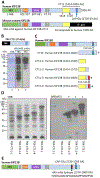LDL receptor related protein 1 requires the I3 domain of discs-large homolog 1/DLG1 for interaction with the kinesin motor protein KIF13B
- PMID: 31487503
- PMCID: PMC6851494
- DOI: 10.1016/j.bbamcr.2019.118552
LDL receptor related protein 1 requires the I3 domain of discs-large homolog 1/DLG1 for interaction with the kinesin motor protein KIF13B
Abstract
KIF13B, a kinesin-3 family motor, was originally identified as GAKIN due to its biochemical interaction with human homolog of Drosophila discs-large tumor suppressor (hDLG1). Unlike its homolog KIF13A, KIF13B contains a carboxyl-terminal CAP-Gly domain. To investigate the function of the CAP-Gly domain, we developed a mouse model that expresses a truncated form of KIF13B protein lacking its CAP-Gly domain (KIF13BΔCG), whereas a second mouse model lacks the full-length KIF13A. Here we show that the KIF13BΔCG mice exhibit relatively higher serum cholesterol consistent with the reduced uptake of [3H]CO-LDL in KIF13BΔCG mouse embryo fibroblasts. The plasma level of factor VIII was not significantly elevated in the KIF13BΔCG mice, suggesting that the CAP-Gly domain region of KIF13B selectively regulates LRP1-mediated lipoprotein endocytosis. No elevation of either serum cholesterol or plasma factor VIII was observed in the full length KIF13A null mouse model. The deletion of the CAP-Gly domain region caused subcellular mislocalization of truncated KIF13B concomitant with the mislocalization of LRP1. Mechanistically, the cytoplasmic domain of LRP1 interacts specifically with the alternatively spliced I3 domain of DLG1, which complexes with KIF13B via their GUK-MBS domains, respectively. Importantly, double mutant mice generated by crossing KIF13A null and KIF13BΔCG mice suffer from perinatal lethality showing potential craniofacial defects. Together, this study provides first evidence that the carboxyl-terminal region of KIF13B containing the CAP-Gly domain is important for the LRP1-DLG1-KIF13B complex formation with implications in the regulation of metabolism, cell polarity, and development.
Keywords: Cholesterol; DLG1; Endocytosis; GAKIN; KIF13A; KIF13B; Kinesin; LRP1; Molecular motor; Protein-protein interaction.
Copyright © 2019 Elsevier B.V. All rights reserved.
Conflict of interest statement
Conflict-of-interest disclosure
The authors declare no competing financial interests.
Figures






Similar articles
-
KIF13B enhances the endocytosis of LRP1 by recruiting LRP1 to caveolae.J Cell Biol. 2014 Feb 3;204(3):395-408. doi: 10.1083/jcb.201309066. Epub 2014 Jan 27. J Cell Biol. 2014. PMID: 24469637 Free PMC article.
-
GAKIN, a novel kinesin-like protein associates with the human homologue of the Drosophila discs large tumor suppressor in T lymphocytes.J Biol Chem. 2000 Sep 15;275(37):28774-84. doi: 10.1074/jbc.M000715200. J Biol Chem. 2000. PMID: 10859302
-
The effector domain of human Dlg tumor suppressor acts as a switch that relieves autoinhibition of kinesin-3 motor GAKIN/KIF13B.Biochemistry. 2007 Sep 4;46(35):10039-45. doi: 10.1021/bi701169w. Epub 2007 Aug 14. Biochemistry. 2007. PMID: 17696365 Free PMC article.
-
Low-density lipoprotein receptor-related protein 1: new functions for an old molecule.Clin Chem Lab Med. 2011 Jun;49(6):967-70. doi: 10.1515/CCLM.2011.154. Epub 2011 Mar 11. Clin Chem Lab Med. 2011. PMID: 21391865 Review.
-
Differential expression of DLG1 as a common trait in different human diseases: an encouraging issue in molecular pathology.Biol Chem. 2019 May 27;400(6):699-710. doi: 10.1515/hsz-2018-0350. Biol Chem. 2019. PMID: 30517074 Review.
Cited by
-
Motor protein KIF13B orchestrates hepatic metabolism to prevent metabolic dysfunction-associated fatty liver disease.Mil Med Res. 2025 Mar 4;12(1):11. doi: 10.1186/s40779-025-00594-3. Mil Med Res. 2025. PMID: 40038775 Free PMC article.
-
KIF13A-A Key Regulator of Recycling Endosome Dynamics.Front Cell Dev Biol. 2022 Apr 25;10:877532. doi: 10.3389/fcell.2022.877532. eCollection 2022. Front Cell Dev Biol. 2022. PMID: 35547822 Free PMC article. Review.
-
Cytoskeletal regulation guides neuronal trafficking to effectively supply the synapse.Curr Biol. 2021 May 24;31(10):R633-R650. doi: 10.1016/j.cub.2021.02.024. Curr Biol. 2021. PMID: 34033795 Free PMC article. Review.
-
A two-kinesin mechanism controls neurogenesis in the developing brain.Commun Biol. 2023 Dec 1;6(1):1219. doi: 10.1038/s42003-023-05604-5. Commun Biol. 2023. PMID: 38040957 Free PMC article.
-
Control of motor landing and processivity by the CAP-Gly domain in the KIF13B tail.Nat Commun. 2023 Aug 5;14(1):4715. doi: 10.1038/s41467-023-40425-4. Nat Commun. 2023. PMID: 37543636 Free PMC article.
References
-
- Hanada T, Lin L, Tibaldi EV, Reinherz EL, Chishti AH, GAKIN, a novel kinesin-like protein associates with the human homologue of the Drosophila discs large tumor suppressor in T lymphocytes, J. Biol. Chem, 275 (2000) 28774–28784. - PubMed
-
- Venkateswarlu K, Hanada T, Chishti AH, Centaurin-alpha1 interacts directly with kinesin motor protein KIF13B, J. Cell Sci, 118 (2005) 2471–2484. - PubMed
-
- Asaba N, Hanada T, Takeuchi A, Chishti AH, Direct interaction with a kinesin-related motor mediates transport of mammalian discs large tumor suppressor homologue in epithelial cells, J. Biol. Chem, 278 (2003) 8395–8400. - PubMed
Publication types
MeSH terms
Substances
Grants and funding
LinkOut - more resources
Full Text Sources
Molecular Biology Databases
Research Materials
Miscellaneous

